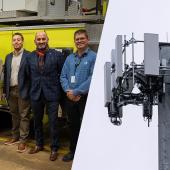This blog is a repost from MissionCritical Communications magazine, originally published on April 11, 2022.
This blog post is part of the "Tech Talk" series focused on the First Responder Network Authority’s (FirstNet Authority) standards development activities to support public safety. This post recaps discussions linked to public safety and other related topics from the 3GPP Plenary meetings that were conducted online March 14-24, 2022. The FirstNet Authority represented public safety interests at the Plenary meetings.
The Third Generation Partnership Project (3GPP) Plenary e-meetings (electronic meetings) concluded on March 24. The major accomplishment was the completion of 3GPP Release 17 (R17). Initial work began in 2019.
There will be the normal follow-on work that also occurred for R15 and R16, including the completion of a limited number of items granted extensions for an additional quarter, and the publication of the exact coding of low-level functions (ASN.1) work in June. R17 completion marks the conclusion of the first phase of the 5G technology evolution, which started in R15. While enhancing various aspects of the 5G system on many fronts, R17 lays the foundation for R18, the inaugural release for 5G Advanced that will include new innovations delivering the 5G vision.
With the approval of the R18 feature set in December 2021, we also saw significant progress on R18 architectural aspects of these features at all levels from the user equipment (UE) — the mobile device — to the core network. There is further discussion in the following reports of the separate plenary e-meetings on progression of R18 work.
The next set of plenary meetings in June are planned to be the first in-person meetings in more than two years. The meetings will be held in Budapest, Hungary, pending any extraordinary events or a pandemic flare-up. 3GPP leadership is watching these issues closely. 3GPP working group meetings in August are intended to be face to face as well, while the meetings in September and October 2022 are expected to be e-meetings as 3GPP attempts to move back to normal face-to-face procedures.
The following Technical Specification Group (TSG) reports include details on each of the Plenary TSG e-meetings with a focus on specific issues of interest regarding R17 and work on mission-critical (MC) R18 features important to public safety. Participation in 3GPP continues to include representatives from nearly all major mobile equipment vendors, chip manufacturers, software vendors and network operators from about 35 countries. The First Responder Network Authority (FirstNet Authority) and government agencies of other nations continue to represent public-safety interests.
Radio Access Network (RAN) Plenary
There were approximately 790 attendees at the TSG RAN March Plenary e-meeting. RAN is responsible for defining the requirements, functions and interfaces of the 3GPP radio network.
The opening session of the e-meeting included a discussion on how to handle some of the open issues related to a limited number of R17 features. After considerable deliberations, the radio aspects of R17, the third major release of the global 5G standard, are considered complete, and any open issues will be handled under normal maintenance activity.
R17 is a major milestone in the evolution of radio standards. R17 ushers in numerous new and enhanced 5G system capabilities while serving as the technology foundation for 5G-Advanced that is the centerpiece of R18. With the addition of support for mobile broadband, industrial automation, non-terrestrial networks (satellite based) and vehicle-to-everything, the R17 feature set supports important public-safety use cases including the need to move large quantities of mission-critical data such as maps and video streams at high priority, efficient use of internet of things (IoT) devices such as body cameras, and expansion of coverage in rural and mountainous areas using satellites.
The Radio Performance and Protocol Aspects (RAN4) working group finalized its feature list for R18. This work adds to and completes the list of major 5G features that were endorsed for R18 during the last plenary.
One of the accepted features deals with defining antenna configurations for both transmit and receive for all frequency bands. This work includes support for Band 14 New Radio (NR) sidelink (direct mode capability which can provide coverage where network coverage is unavailable) for both power class 1 devices (31 dBm, aka high power UEs) and power class 3 devices (23 dBm, aka normal power UEs). Finally, a work item that specifies RF requirements for coexistence between an air-to-ground (ATG) network and the terrestrial network was included. The ATG network refers to an in-flight connectivity technique using ground-based cell towers that send signals up to an aircraft’s ATG antenna(s). This feature enhances communication abilities that will benefit public safety, particularly helicopters and search-and-rescue aircraft. The list of R18 features of high importance to public safety is given at the end of the next plenary report.
Service and System Aspects (SA) Plenary
There were slightly more than 375 attendees for the TSG SA December Plenary meeting, which is responsible for the overall architecture and service capabilities of 3GPP-based systems.
The SA1 working group began work on R19 requirements using a new procedure. SA1 previously agreed to new studies one by one, with no complete vision of the release. The new process for R19 uses a window of two meetings to present the studies, and two meetings to agree to the studies. If too many studies are presented, a prioritization process will be used to help select the R19 feature set. SA1 typically works one specification release ahead of all the other working groups to create the requirements.
At this time six studies have been approved. There is one more meeting to finalize the R19 content with 17 study item proposals still on the table. For public safety, the approved study on railway evolution will continue to enhance and add requirements for mission-critical communications. A study on multihop, multipath relays for extended coverage will have the FirstNet Authority’s support to make the final cut.
The SA2 working group reported that it started progressing the development of R18 architecture technical reports for work items prioritized and approved in the December 2021 SA Plenary. SA2 reported good progress on high-priority items for public safety including 5G proximity-based services (5G ProSe) enhancements to support UE-to-UE relay for extending the range of off-network communications, 5G multicast-broadcast services (5MBS) enhancements to support the case of clusters of high numbers of public-safety UEs, vehicle mounted relay (VMR) to extend coverage, and the very important location-based services enhancements and range-based services to improve situational awareness.
The SA2 working group had previously reported the completion of R17 architecture technical specifications with some exceptions for open issues that needed input from RAN working groups and from the SA3 security working group. The work has progressed to address these exceptions. SA2 declared the architectural technical report and technical specifications for R17 5G ProSe at 100% completion and R17 5MBS at 99% completion. As previously mentioned, the progress of both 5G ProSe and 5MBS in R17 is key to enabling the SA6 working group to complete technical specifications work on MC services over 5G in R18.
The SA3 working group reported to the SA Plenary that almost all remaining R17 work areas focused on security aspects of enhancements for edge computing in 5G and security aspects of uncrewed aerial systems (UAS) have been completed as planned. This represents a significant amount of work on security aspects during the first quarter of 2022. As is often the case in SA3, some security focused study areas have been automatically extended into R18, allowing SA3 to follow its process for deciding if security topics will require specification work.
While almost all the specification work for security of the 5G ProSe UE-to-network relay was completed in just six months, SA3 had an initial target completion date of March. An exception was approved to address some critical items that have not yet reached consensus within SA3. These items include a control plane-based security procedure for 5G ProSe communication via Layer-3 UE-to-network relay, details on the security of UE-to-network relay’s discovery procedures, and details on the control-plane-based secondary authentication procedures, as well as some other clarifications. The approval of this exception will give SA3 the time needed to ensure a viable, secure 5G ProSe UE-to-network relay feature in R17. Public safety requires the ability to communicate among first responders in all situations, whether in or out of network coverage. The UE-to-network relay capability allows off-network UEs to use another UE as a relay to and from the network, keeping the first responder in touch.
The SA6 working group is working diligently on the R18 Stage 2 architectures for MC services and other verticals. The new study on ad hoc group communications (AHGC) for MC services made substantial progress in its first meeting. AHGC allows authorized users to make a group call to a set of users based on implementation-specific criteria (e.g., proximity, selected from contacts) without first configuring the group in the group management server. The AHGC study is investigating architectural issues around the requirements specified by SA1 including a key new requirement recently added by the railway community. Railways are interested in using AHGC for their critical and complex railway emergency alert feature.
In other areas, SA6 reported significant progress on two work items related to MC services over 5G: MC services over 5MBS and MC services over 5G ProSe. Multicast/broadcast and off-network communication are two key MC enablers that are undergoing significant changes for 5G. SA6 is defining architecture changes for MC services to accommodate the 5G versions of these enablers. SA6 also continues to progress application-level architectures for non-MC services, and this work can potentially be leveraged for MC services. Examples include application enablement architectures for edge computing, network slicing, messaging services and UAS.
In the work on R18 over the next 15-18 months, the FirstNet Authority will be paying special attention to the work items that are most important for public safety: mobile integrated access and backhaul (mobile-IAB, aka VMR), 5G over satellite (non-terrestrial network), location services, ranging-based services, 5MBS, 5G ProSe, 5G security and MC service enhancements including ad hoc group support.
Core Network and Terminals (CT) Plenary
There were about 335 attendees for the March TSG CT Plenary e-meeting, which covers the protocol details that follow the requirements and architectural work performed in the SA TSG.
The majority of time was spent on discussions to finalize R17 feature implementations. The plenary e-meeting successfully completed 116 features for R17. There were 27 features that have small amounts of work to be completed. The CT plenary used a regular 3GPP mechanism to approve “exceptions” for each of these 27 features that detail the specific work to be done and indicate that all work is expected to be accomplished by the CT plenary meeting in June 2022. These procedures were also used in previous 3GPP releases, notably in R15 and R16 that defined the 5G system.
Regarding R17 mission-critical features, some of the most useful to public safety include enhanced location services, additions to mission-critical data (MCData) capabilities, expansion of mission-critical video (MCVideo) to handle regrouping, use of functional alias (e.g., attaching a label such as “incident commander” to a person), security enhancements, 5G ProSe over the 5G NR sidelink, 5G relay UE and MC services over 5G. While most of these features are now complete, the finalizing work will continue in the second quarter of 2022, including complex technical work on 5G ProSe and support of MC services over 5G. The FirstNet Authority is working with other companies to ensure that the work is completed on time.
Further information on the 3GPP’s work and organization can be found at: www.3gpp.org.


















